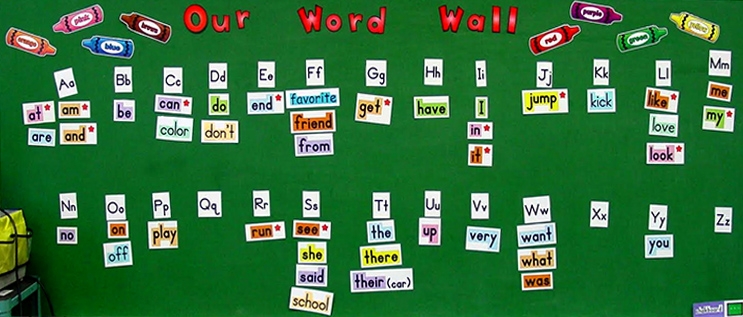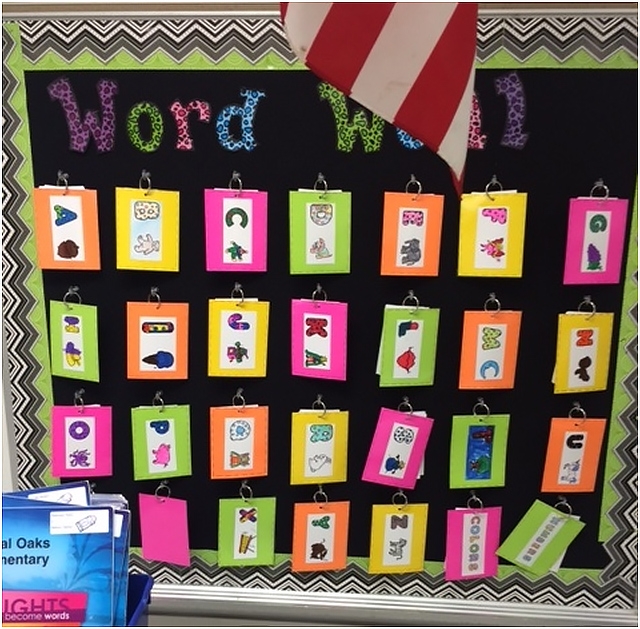
A word wall is a collection of words which are displayed in large visible letters on a wall, bulletin board, or other display surface in a classroom. The word wall is designed to be an interactive tool for students and contains an array of words that can be used during writing and reading. (Reading Rockets)
The Importance of Word Walls
The walls of the literacy classroom can have an important influence on student learning (Wolfersberger, et al, 2004). Although Word Walls are typical features in a primary classroom, they can be visible and concrete learning supports that can expand students’ vocabulary and provide ongoing concrete examples of new concepts and ideas learned at all levels (Brabham & Villaume, 2001).
Word Walls Can:
- Provide visual cues and supports for students
- each new and meaningful vocabulary
- Extend learning of new vocabulary and sight words into writing and speaking
- Reinforce understanding of content specific ideas, terms and concepts
- Provide connections of new words across content areas
- Encourage increased student independence when reading and writing
- Collect interesting and challenging vocabulary words to integrate into speaking and writing
- Support student awareness of spelling rules and patterns
- Increase secondary students’ understanding of Greek and Latin roots and affixes
Regardless of the grade level or class, word walls are most effective when they are interactive and connected to ongoing learning.
Interactive Word Walls
Interactive Word Walls that require students to go beyond just a visual connection to actually using the words on the wall incorporates student choice and has shown to increase student motivation to learn new concepts and vocabulary. Elementary teachers make word walls interactive by attaching Velcro to the back of words, providing multiple copies of words in a paper pocket or attaching rings to the words (see photo) so that students can take the words to their desk as a resource during writing activities.

A study of middle school use of interactive word walls reported that 80% of students shared that they used the word walls for studying, remembering, writing, and completing assignments and felt they were beneficial to their understanding. Students shared new words with the class and discussed why they chose specific words while providing a short mini lesson to help peers learn the word before adding it to the wall. Students were asked to use the word in discussions and writing in content classes and to add new words and concepts that they found interesting or helpful to the word wall.
Interactive Word Wall Activity Ideas
Whole Class Activities
- Mystery Word
Scramble the letters and place them on the white board. Have students work together to figure out what the word is and create clues to helps other solve the mystery of the word and its meaning - Interloping Word
As you build a substantial word wall, secretly add a new word and have students hunt for it within all the existing words. - Guess My Word
Students choose a word and write a poem about the word without naming it. Peers guess what the word is.
Whole Class Activities
- Word Connections
Students choose a word and work with a partner or in a small group to create connections among their words. - Pictionary
Students have word wall cards and choose one. Using only their ability to draw, students give clues to their team in order for them to guess the word. - Parts of Speech
Students have word wall cards and choose one. They have to determine the part of speech the word represents and create a sentence. The next person in the group draws a card, determines the part of speech and creates a sentence using both words. The game continues until it is an impossibly long and ridiculous sentence.
Consider what purpose a word wall can serve in your classroom. Be sure to place the word wall where it is accessible to students and can be seen!
This article is #3 in the twelve-part series, “Getting My Classroom Ready for Balanced Literacy Instruction: Classroom Culture and Environment.”